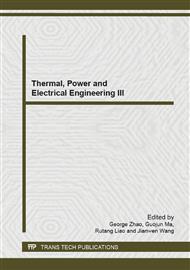[1]
Lin Haixue. Some problems in national standard for harmonics in public supply network[J]. Power System Technology, 2003, 27(1): 65-70. (In Chinese).
Google Scholar
[2]
Deng Shujuan, Lei Longfu, Li Yong. Characteristic analysis on inter-harmonics and sub-harmonics in the new type of industry converting system[J]. Power System Technology, 2009, 33(5): 28-33. (In Chinese).
Google Scholar
[3]
Yang Shaobing, Wu Mingli. Assessing harmonic emission levels of traction substations based on simulated annealing algorithm[J]. Automation of Electric Power Systems, 2011, 35(11): 60-64. (In Chinese).
Google Scholar
[4]
GB/T 14549-1993, power quality Quality of electric supply Harmonics in public supply network[S].
Google Scholar
[5]
Zhang Wei, Yang Honggeng. A method for assessing harmonic emission level based of binary linear regression[J]. Proceedings of the CSEE, 2004, 24(6): 50-54. (In Chinese).
Google Scholar
[6]
Che Quan, Yang Honggeng. Assessing the harmonic emission level based on robust regression method[J]. Proceedings of the CSEE, 2004, 24(4): 39-44. (In Chinese).
Google Scholar
[7]
Huang Shun, Xu Yonghai. Assessing harmonic impedance and the harmonic emission level based on partial least-squares regression method[J]. Proceedings of the CSEE, 2007, 27(1): 93-97. (In Chinese).
DOI: 10.1109/icpst.2006.321428
Google Scholar
[8]
Jia Xiufang,Hua Huichun, Cao Dongsheng, et al. Determining harmonic contributions based on complex least squares method[J]. Proceedings of the CSEE, 2013, 33(4): 149-155. (In Chinese).
Google Scholar
[9]
Hua Huichun, Jia Xiufang, Cao Dongsheng, et al. Practical method to determine the harmonic contribution of a specific harmonic load[C]/15th IEEE International Conference on Harmonics and Quality of Power. Hong Kong: IEEE Power & Energy Society, 2012: 769-773.
DOI: 10.1109/ichqp.2012.6381203
Google Scholar
[10]
Hua Huichun, Jia Xiufang, Zhang Shaoguang. Neighborhood multi-point measurement method for harmonic contribution determination[J]. Power System Technology, 2014, 38(2): 502-508. (In Chinese).
Google Scholar
[11]
M.P. Wand, M.C. Jones. Kernel smoothing[M]. CRC Press, 1995, 70-72.
Google Scholar
[12]
Meng Jiafu, Zhang Riquan, Lv Shiqin. Estimation of semivarying-coefficient models with the correlated random errors[J]. Applied probability and statistics, 2010, 26(5): 477-479. (In Chinese).
Google Scholar
[13]
Gursoy E, Niebur D. Harmonic load identification using complex independent component analysis[J]. IEEE Trans on Power Delivery, 2009, 24(1): 285-292.
DOI: 10.1109/tpwrd.2008.2002968
Google Scholar


